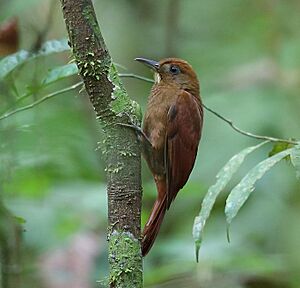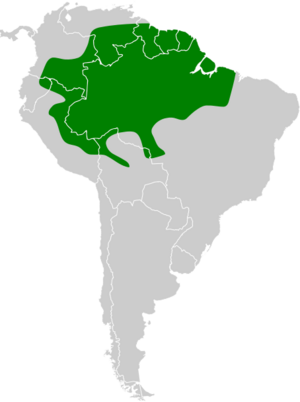White-chinned woodcreeper facts for kids
Quick facts for kids White-chinned woodcreeper |
|
|---|---|
 |
|
| Conservation status | |
| Scientific classification | |
| Genus: |
Dendrocincla
|
| Species: |
merula
|
 |
|
The white-chinned woodcreeper (Dendrocincla merula) is a cool bird that lives in the Amazon Basin. It's part of the ovenbird family called Furnariidae. You can find this bird in many South American countries. These include Bolivia, Brazil, Colombia, Ecuador, French Guiana, Guyana, Peru, Suriname, and Venezuela.
Contents
Types of White-chinned Woodcreepers
Just like there are different types of dogs, there are different types of white-chinned woodcreepers. These are called subspecies. Scientists have found seven different subspecies of this bird.
- D. m. bartletti
- D. m. merula
- D. m. obidensis
- D. m. remota
- D. m. olivascens
- D. m. castanoptera
- D. m. badia
Some of these subspecies, like D. m. merula and D. m. obidensis, sound different and have different eye colors. This makes scientists wonder if they might actually be separate species!
What They Look Like
The white-chinned woodcreeper is a medium-sized bird. It has a fairly short, straight beak. These birds are about 16 to 21 cm (6.3 to 8.3 in) long. Males and females weigh about the same, from 28 to 54 g (0.99 to 1.90 oz).
The D. m. merula and D. m. obidensis subspecies are bigger than the others. All white-chinned woodcreepers, both male and female, have similar feathers.
Most of their top feathers are dark reddish-brown. Their wing feathers and tail are a bit redder. They have a thin white or yellowish stripe on their chin and throat. Their chest is dark olive-brown, turning reddish-brown near their tail. Their eyes can be reddish-brown or brown. Their beaks are brownish to black, often lighter on the bottom. Their legs and feet can be bluish, olive, gray, or brownish.
The other five subspecies have gray or bluish eyes. They are also generally lighter in color. For example, D. m. remota is the palest. D. m. badia is redder and has a wider, whiter throat stripe than all the others.
Where They Live and Their Home
The white-chinned woodcreeper lives in the Amazon Basin. Each subspecies lives in a slightly different area:
- D. m. bartletti: Central Colombia and Venezuela, south through eastern Ecuador and Peru, into northern Bolivia and western Brazil.
- D. m. merula: The Guianas and northern Brazil.
- D. m. obidensis: Brazil, north of the Amazon River, from the Rio Negro east to the Atlantic Ocean.
- D. m. remota: Eastern Bolivia and possibly nearby western Brazil.
- D. m. olivascens: Brazil, south of the Amazon River, between the Rio Madeira and Rio Tapajós.
- D. m. castanoptera: Brazil, south of the Amazon River, between the Rio Tapajós and Rio Tocantins.
- D. m. badia: Brazil, south of the Amazon River, between the Rio Tocantins and the Atlantic Ocean.
These birds love humid places, especially dense forests. They are usually found close to the ground in the forest. They mostly live below 300 meters (980 ft) in elevation. However, in some western areas, they can be found up to 600 meters (2,000 ft) high.
Behavior
Movement
White-chinned woodcreepers usually stay in the same area all year. However, they do move around a little bit locally within their home range.
Feeding Habits
These birds have a very interesting way of finding food! They are "obligate followers" of army ant swarms. This means they almost always follow these ants to eat.
They usually perch on a branch or cling to a tree trunk near the ground. When the army ants march through the forest, they scare insects and other small creatures out of hiding. The woodcreeper then quickly flies down to catch these creatures. They do not eat the ants themselves. Sometimes, they might even catch small animals trying to escape the ants.
In some parts of Brazil, one or two woodcreepers might follow an ant swarm. But in Peru, up to eight have been seen together! They will chase away smaller birds from the ant swarm. But bigger birds will chase them away.
Reproduction
Scientists don't know a lot about how white-chinned woodcreepers raise their young. Their breeding season changes depending on where they live. It's usually from February to May in the northern parts of their range. It gets later as you go further south.
It seems they don't stay with one partner for a long time. Scientists think they probably nest in holes in trees. However, no one has ever found or described a nest yet. We also don't know how many eggs they lay, how long the eggs take to hatch, or how long it takes for the young birds to leave the nest.
What They Sound Like
The D. m. merula and D. m. obidensis subspecies have a loud song. It's a series of 6 to 9 clear whistle notes, like "kew, kew, kew, kew, kew, kewp." Their call sounds like a sharp "deet-eet-ee."
The other subspecies have lower-pitched songs. In Colombia, their song has been described as "we, wi, di, dit" or "wi-wid-wid-di." Their calls include sounds like "dit-it-it-it" or "tat-at-at."
Conservation Status
The IUCN (International Union for Conservation of Nature) has listed the white-chinned woodcreeper as a species of "Least Concern." This means they are not currently in danger of disappearing.
They live in a very large area. However, their total population size is not known, and it is thought to be getting smaller. No immediate big threats have been found. They are generally not very common, but you can find many in certain local areas.
Like other birds that follow army ants, they are very sensitive to changes in the forest. If the forest is broken up or disturbed, they tend to disappear from those areas.


